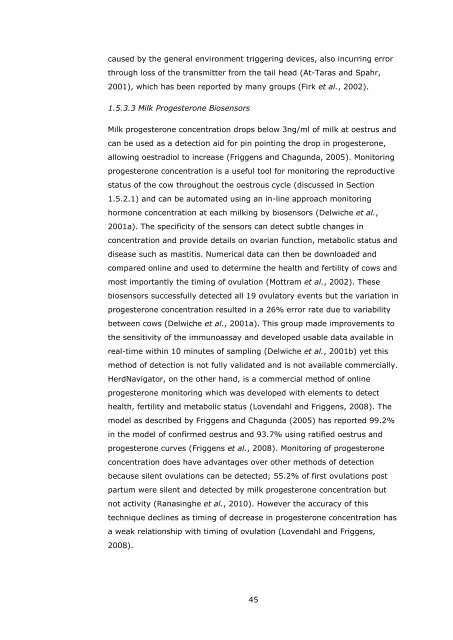novel approaches to expression and detection of oestrus in dairy cows
novel approaches to expression and detection of oestrus in dairy cows
novel approaches to expression and detection of oestrus in dairy cows
You also want an ePaper? Increase the reach of your titles
YUMPU automatically turns print PDFs into web optimized ePapers that Google loves.
caused by the general environment trigger<strong>in</strong>g devices, also <strong>in</strong>curr<strong>in</strong>g error<br />
through loss <strong>of</strong> the transmitter from the tail head (At-Taras <strong>and</strong> Spahr,<br />
2001), which has been reported by many groups (Firk et al., 2002).<br />
1.5.3.3 Milk Progesterone Biosensors<br />
Milk progesterone concentration drops below 3ng/ml <strong>of</strong> milk at <strong>oestrus</strong> <strong>and</strong><br />
can be used as a <strong>detection</strong> aid for p<strong>in</strong> po<strong>in</strong>t<strong>in</strong>g the drop <strong>in</strong> progesterone,<br />
allow<strong>in</strong>g oestradiol <strong>to</strong> <strong>in</strong>crease (Friggens <strong>and</strong> Chagunda, 2005). Moni<strong>to</strong>r<strong>in</strong>g<br />
progesterone concentration is a useful <strong>to</strong>ol for moni<strong>to</strong>r<strong>in</strong>g the reproductive<br />
status <strong>of</strong> the cow throughout the oestrous cycle (discussed <strong>in</strong> Section<br />
1.5.2.1) <strong>and</strong> can be au<strong>to</strong>mated us<strong>in</strong>g an <strong>in</strong>-l<strong>in</strong>e approach moni<strong>to</strong>r<strong>in</strong>g<br />
hormone concentration at each milk<strong>in</strong>g by biosensors (Delwiche et al.,<br />
2001a). The specificity <strong>of</strong> the sensors can detect subtle changes <strong>in</strong><br />
concentration <strong>and</strong> provide details on ovarian function, metabolic status <strong>and</strong><br />
disease such as mastitis. Numerical data can then be downloaded <strong>and</strong><br />
compared onl<strong>in</strong>e <strong>and</strong> used <strong>to</strong> determ<strong>in</strong>e the health <strong>and</strong> fertility <strong>of</strong> <strong>cows</strong> <strong>and</strong><br />
most importantly the tim<strong>in</strong>g <strong>of</strong> ovulation (Mottram et al., 2002). These<br />
biosensors successfully detected all 19 ovula<strong>to</strong>ry events but the variation <strong>in</strong><br />
progesterone concentration resulted <strong>in</strong> a 26% error rate due <strong>to</strong> variability<br />
between <strong>cows</strong> (Delwiche et al., 2001a). This group made improvements <strong>to</strong><br />
the sensitivity <strong>of</strong> the immunoassay <strong>and</strong> developed usable data available <strong>in</strong><br />
real-time with<strong>in</strong> 10 m<strong>in</strong>utes <strong>of</strong> sampl<strong>in</strong>g (Delwiche et al., 2001b) yet this<br />
method <strong>of</strong> <strong>detection</strong> is not fully validated <strong>and</strong> is not available commercially.<br />
HerdNaviga<strong>to</strong>r, on the other h<strong>and</strong>, is a commercial method <strong>of</strong> onl<strong>in</strong>e<br />
progesterone moni<strong>to</strong>r<strong>in</strong>g which was developed with elements <strong>to</strong> detect<br />
health, fertility <strong>and</strong> metabolic status (Lovendahl <strong>and</strong> Friggens, 2008). The<br />
model as described by Friggens <strong>and</strong> Chagunda (2005) has reported 99.2%<br />
<strong>in</strong> the model <strong>of</strong> confirmed <strong>oestrus</strong> <strong>and</strong> 93.7% us<strong>in</strong>g ratified <strong>oestrus</strong> <strong>and</strong><br />
progesterone curves (Friggens et al., 2008). Moni<strong>to</strong>r<strong>in</strong>g <strong>of</strong> progesterone<br />
concentration does have advantages over other methods <strong>of</strong> <strong>detection</strong><br />
because silent ovulations can be detected; 55.2% <strong>of</strong> first ovulations post<br />
partum were silent <strong>and</strong> detected by milk progesterone concentration but<br />
not activity (Ranas<strong>in</strong>ghe et al., 2010). However the accuracy <strong>of</strong> this<br />
technique decl<strong>in</strong>es as tim<strong>in</strong>g <strong>of</strong> decrease <strong>in</strong> progesterone concentration has<br />
a weak relationship with tim<strong>in</strong>g <strong>of</strong> ovulation (Lovendahl <strong>and</strong> Friggens,<br />
2008).<br />
45
















